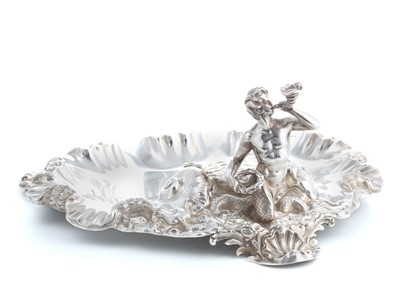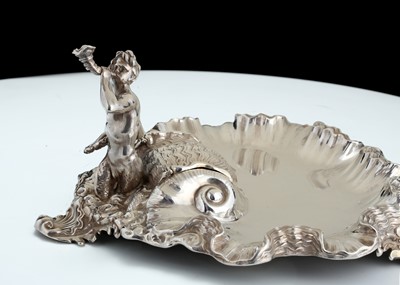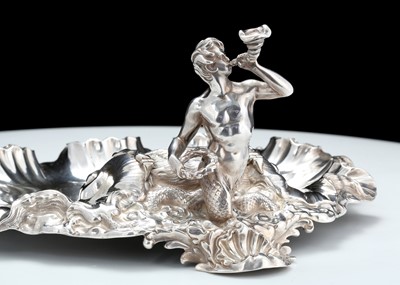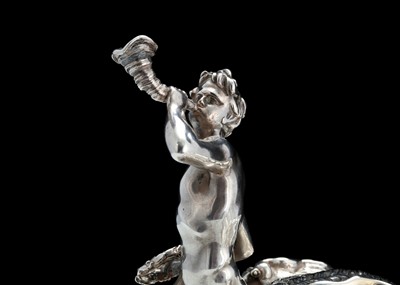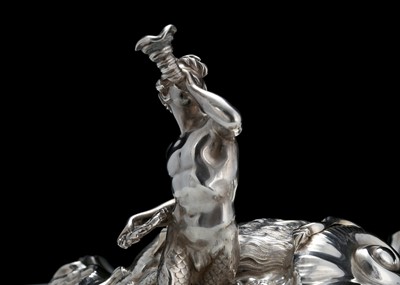4th Apr, 2017 10:00
Carpets and Rugs / Silver & Objects of Vertu
The Harington Inkstand by Paul Storr – A very rare William IV silver inkstand, London 1836
Formed as an outswept shell upon three scallop shell feet, the top section with a rocaille decorated lidded ink compartment surmounted by a figure of triton with a stylised conch shell horn held to lips, with a wreath to the other hand, rising from the waves with each leg formed as a scaled fish tail. Fully marked underneath and part marked to the ink compartment lid, also stamped ‘Storr & Mortimer’ underneath.
Width – 30 cm / 11.75 inches
Length – 27 cm /10.6 inches
Height – 13.25 cm / 5.25 inches
Weight – 853 grams / 27.42 ozt
The depiction of Triton, son of Poseidon and Amphitrite the messenger of the sea with two mer-tails for each leg is seen similarly in Bernini’s Fontana del Tritone of 1642-3. A version of Triton, in this instance with human legs but of similar stance and shell form is found in ‘Triton blowing a conch shell’ Adriaen de Vries c.1615-8 in the Rijksmuseum. A design for salts by Paul Storr of 1813[1] showing triton with bi-tailed lower half supporting a conch shell was modelled by Edward Hodges Baily (1788 – 1867) based upon Thetis returning from Vulcan with arms for Achilles by William Theed the elder (1767 – 1817). Christopher Hartrop notes on “[t]he addition of shells and other nautical motifs, symbolic of Venus, gave expression to the ancient maxim that without food and wine, love withers. The sea provided the inspiration for much of the decoration of the imperial style, alluding not only to Venus but also to Britain’s sea faring might …”[2]
The Grand Service created in 1826/7 for George IV by Rundell, Bridge and Rundell had tureens described as ‘4 richly chased gilt shell pattern Soup Tureens supported by Sea Horses with Triton handle’. The handle in question bears strong resemblance to that on this inkwell showing a youthful triton with a bi-tailed lower half, however blowing a conch shell with both arms. This design of inkwell is seen in an earlier incarnation by Storr of 1829, bearing the same triton figure and overall design but lacking the scallop shell feet seen present here.
Provenance – from the family collection of the late Sir Nicholas Harington (1942 -2016), 14th Baronet Harington of Ridlington, co. Rutland [E., 1611], uncle to contemporary actor Kit Harrington.”
[1] P. 71 Hatrop, C., 2015. Art in Industry The Silver of Paul Storr.Cambridge. John Adamson.
[2] Ibid, P. 70
Sold for £8,500
Includes Buyer's Premium
Do you have an item similar to the item above? If so please click the link below to submit a free online valuation request through our website.

